Understanding Woodpeckers in Florida: Actions, Variety, and Environments
Understanding Woodpeckers in Florida: Actions, Variety, and Environments
Blog Article
Woodpeckers: A Comprehensive Overview to Understanding These One-of-a-kind Birds
Woodpeckers, with their unique habits and physical qualities, have long astounded the interest of ornithologists and nature lovers alike. From their balanced drumming resembling through the timbers to their impressive adaptations for scaling tree trunks with ease, these birds offer an interesting study in bird biology. However, what genuinely sets woodpeckers apart is not simply their striking look yet likewise their vital function in preserving the fragile equilibrium of ecological communities. As we explore the elaborate composition, diverse species, and eco-friendly value of woodpeckers, a much deeper admiration for these special birds and the secrets they hold unravels.

Woodpeckers' Drumming Behavior
Woodpeckers exhibit a balanced and precise drumming habits that offers various necessary features in their day-to-day lives. This actions is largely connected with interaction, area defense, and foraging. The distinct drumming noise is produced by the rapid pecking of their beaks versus difficult surfaces such as tree trunks, branches, or also metal things.
Interaction is an essential facet of woodpecker actions, and drumming plays a considerable function in this procedure. Woodpeckers make use of drumming to develop their existence, draw in friends, and maintain call with their partners and children. The frequency, strength, and duration of drumming series convey specific messages to other woodpeckers in the location.
Along with communication, woodpeckers utilize drumming habits for area defense. Woodpeckers in Florida. The loud and recurring drumming offers as an alerting to possible intruders, indicating that the area is already asserted. By establishing their territory with drumming, woodpeckers reduce the probability of conflicts over useful sources such as food and nesting websites
Moreover, woodpeckers additionally utilize drumming as a foraging method. The balanced pecking aids them locate bugs concealing beneath the bark of trees by producing resonances that interrupt the prey's concealment. This behavior showcases the flexibility and ingenuity of woodpeckers in utilizing their drumming skills for several vital objectives.
One-of-a-kind Adjustments for Tree Climbing
Having grasped the art of drumming to communicate, defend region, and forage, woodpeckers have progressed distinct adjustments that promote their impressive climbing capacities in their arboreal environments. One key adaptation is their customized feet. Woodpeckers have zygodactyl feet, with two toes directing forward and two toes pointing backward. This arrangement supplies a strong grasp on the upright surface areas of trees, allowing them to stick easily while foraging for insects or drumming. Additionally, woodpeckers have stiff tail feathers that serve as a prop to support their bodies as they climb. These tail feathers provide security and equilibrium, allowing woodpeckers to steer up go to website tree trunks with accuracy and agility.
Moreover, woodpeckers have powerful neck muscles and an one-of-a-kind head framework that help in their climbing up abilities. Their solid neck muscles enable them to swiftly eat tree bark without experiencing whiplash, while their thick head and tiny brain work as shock absorbers, securing them from the influence of repeated drumming. These adjustments collectively allow woodpeckers to browse the vertical globe of trees with performance and elegance.

Duty of Woodpeckers in Ecosystems
Playing a crucial function in forest ecological communities, woodpeckers contribute significantly to the equilibrium and wellness of their environments via their distinct habits and interactions with various other species. One of the crucial ecological features of woodpeckers is their role in managing insect populations. By foraging for insects under the bark of trees, woodpeckers help manage bug populaces, avoiding outbreaks that might hurt the overall health and wellness of the forest. In addition, woodpeckers produce dental caries in trees that function as critical nesting websites for a range of other bird types, promoting biodiversity within the community.
Additionally, the drumming and articulations of woodpeckers play an essential role in communication and territory establishment. These noises not just serve to bring in mates but additionally aid define limits in between various woodpecker territories, lowering disputes and advertising a harmonious conjunction within the forest neighborhood. that site Overall, the presence of woodpeckers in forest communities highlights their importance as keystone varieties, affecting the characteristics and functioning of these environments in diverse ways.
Composition: Specialized Beaks and Feet
In the complex web of forest environments, the specialized beaks and feet of woodpeckers are important adaptations that enable them to accomplish their vital eco-friendly duties. Woodpeckers possess unique anatomical features that are especially made to This Site help them in their foraging and nesting habits.
The most distinguishing characteristic of woodpeckers is their solid, chisel-shaped beaks. These beaks are completely adapted for exploration into wood to uncover pests, larvae, and sap concealed underneath the bark of trees. The strong muscle mass and strong framework of their beaks permit woodpeckers to eat a rate of approximately 20 times per secondly without creating damages to their skulls.
In addition, woodpeckers have specialized feet that help in their acrobatic climbing capabilities. Their feet have 2 toes pointing onward and two toes directing backward, providing a strong grip on vertical surface areas (Woodpeckers in Florida). This distinct foot arrangement, together with stiff tail feathers that act as a helpful prop, permits woodpeckers to hold on to tree trunks and branches effortlessly while they look for food or dig deep into nesting dental caries
Woodpecker Species Variety
Woodpeckers are a diverse team of birds discovered across numerous ecological communities worldwide, with over 200 recognized varieties exhibiting adjustments to various environments. Woodpeckers have advanced to live in a variety of environments, from forests and timberlands to meadows and deserts, each offering distinct challenges that have actually affected the evolution of unique woodpecker varieties.
These adaptations make it possible for woodpeckers to forage efficiently in their respective environments, decreasing competitors amongst varieties and advertising niche distinction. In addition, geographic seclusion and historical aspects have played a function in forming the circulation and diversity of woodpecker types, leading to the vast variety of specialized adaptations seen in these fascinating birds.

Verdict
In final thought, woodpeckers are remarkable birds that display one-of-a-kind drumming actions, specialized adaptations for tree climbing, and play essential functions in communities. With a diverse variety of woodpecker species found worldwide, these birds are necessary for maintaining the health and balance of woodlands and woodlands.
Report this page